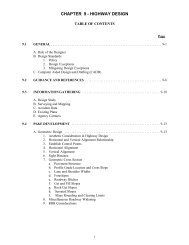Baltimore-Washington Parkway Widening Feasibility Study
Baltimore-Washington Parkway Widening Feasibility Study
Baltimore-Washington Parkway Widening Feasibility Study
- No tags were found...
Create successful ePaper yourself
Turn your PDF publications into a flip-book with our unique Google optimized e-Paper software.
<strong>Baltimore</strong>-<strong>Washington</strong> <strong>Parkway</strong> <strong>Widening</strong> <strong>Feasibility</strong> <strong>Study</strong>Traffic and Transportation Impacts5.0TrafficandTransportationImpactsBecause the objective of this study is to assess the feasibility of increasing vehicular carrying capacityand reducing travel time for users of the B-W <strong>Parkway</strong> facility within its historic and legislative context, adiscussion of the transportation operation impacts resulting from widening is necessary.5.1DefinitionandPurposeFor the purposes of this feasibility study, traffic and transportation impacts were determined byperforming an operations analysis of the future traffic conditions of the <strong>Parkway</strong>. Future traffic volumeforecasts of the <strong>Parkway</strong> were used to determine the traffic demand throughout the corridor. Theoperational analysis results were used to assess the potential benefits in terms of reduced congestion orimproved travel time associated with capacity improvement. The future traffic volume forecastsincluded growth related to BRAC activities within and around Fort George G. Meade on the <strong>Parkway</strong> sothat any resulting impacts could also be assessed.5.2MethodologyThe methodology used in this feasibility study to assess the transportation impacts of the wideningoptions on the B-W <strong>Parkway</strong> consisted of the application of the following data sources, assumptions,tools, and methods:Existing (2005) and future (2040) forecasted traffic volumes estimates were obtained from theMetropolitan <strong>Washington</strong> Council of Governments regional travel demand model. Estimates of AMand PM peak period demands were converted to estimates of AM and PM peak 1-hour volumes.An operational analysis was performed using the Freeway Module of the Highway Capacity Software(HCS) 2010 version. This module was used to calculate operational attributes for the B-W <strong>Parkway</strong>given mainline traffic volumes and number of lanes.An HCS analysis was performed to obtain level-of-service for each mainline segment (i.e.interchange-to-interchange) along the <strong>Parkway</strong> for the AM and PM peak hours.5.2.1LimitationsoftheTransportationAnalysisIn harmony with the language mandated in the congressional legislation for this study, thetransportation analysis included a basic review of the mainline traffic volumes for the B-W <strong>Parkway</strong>. Theanalysis did not include the following:A review of interchange geometry including auxiliary lanes, acceleration and deceleration lanes,ramps, and cross street typical sections.A review of traffic operations at existing interchanges and ramps.A review of the queuing effects from downstream traffic bottlenecks.43 November 2012
















